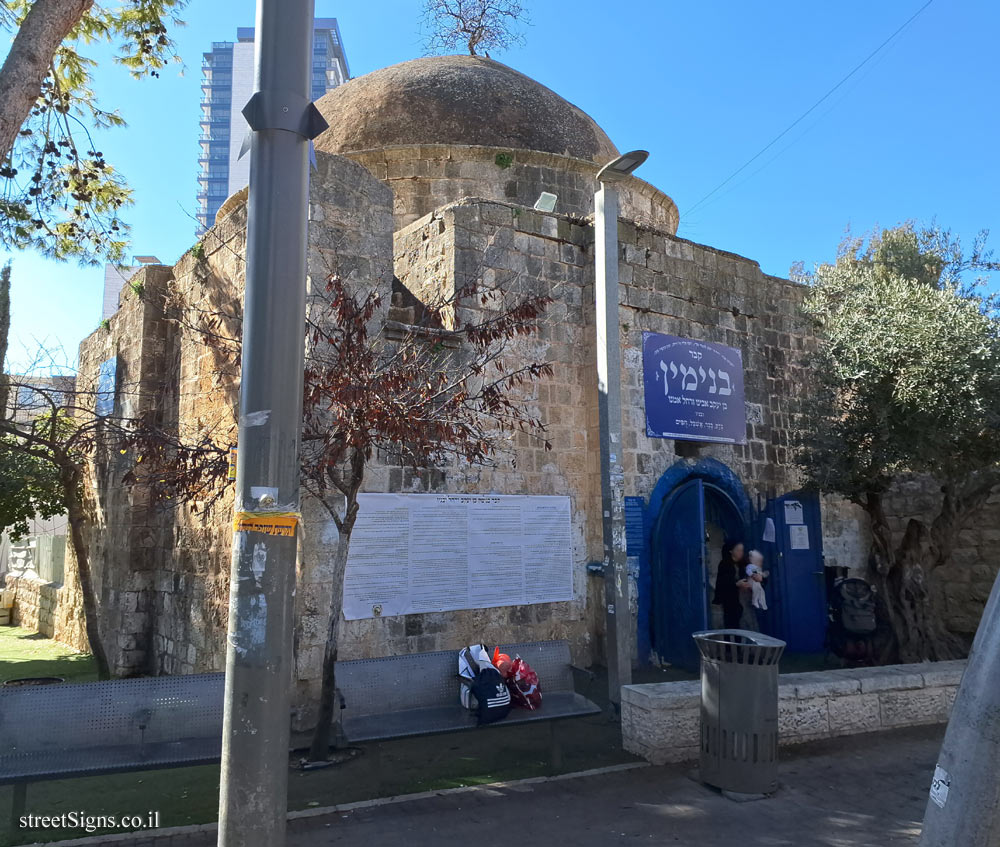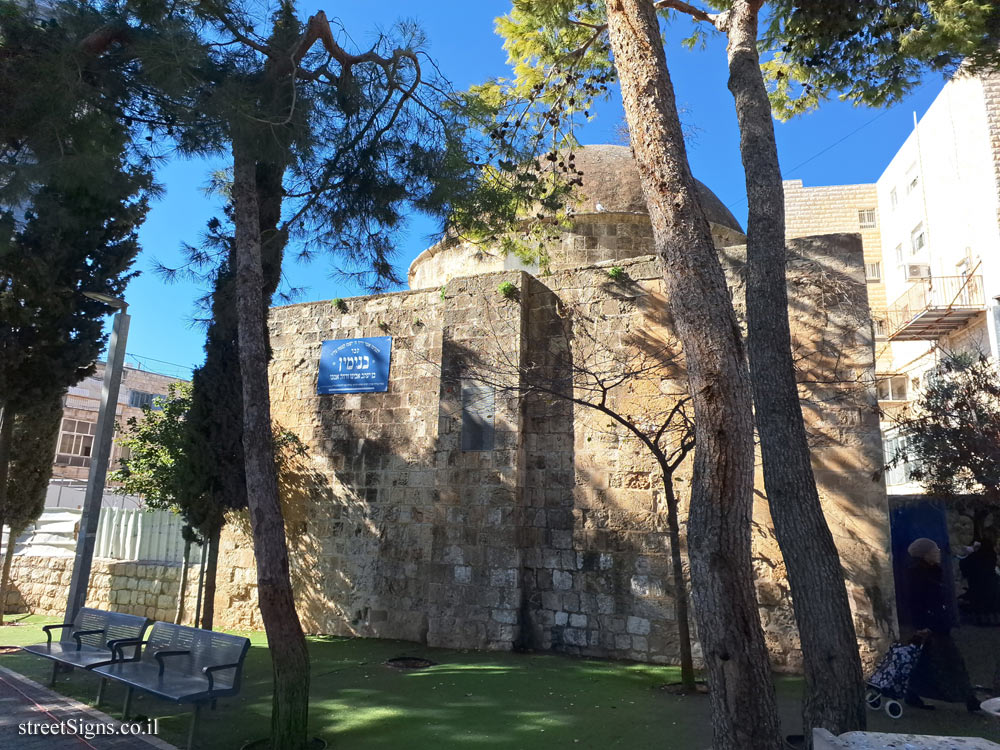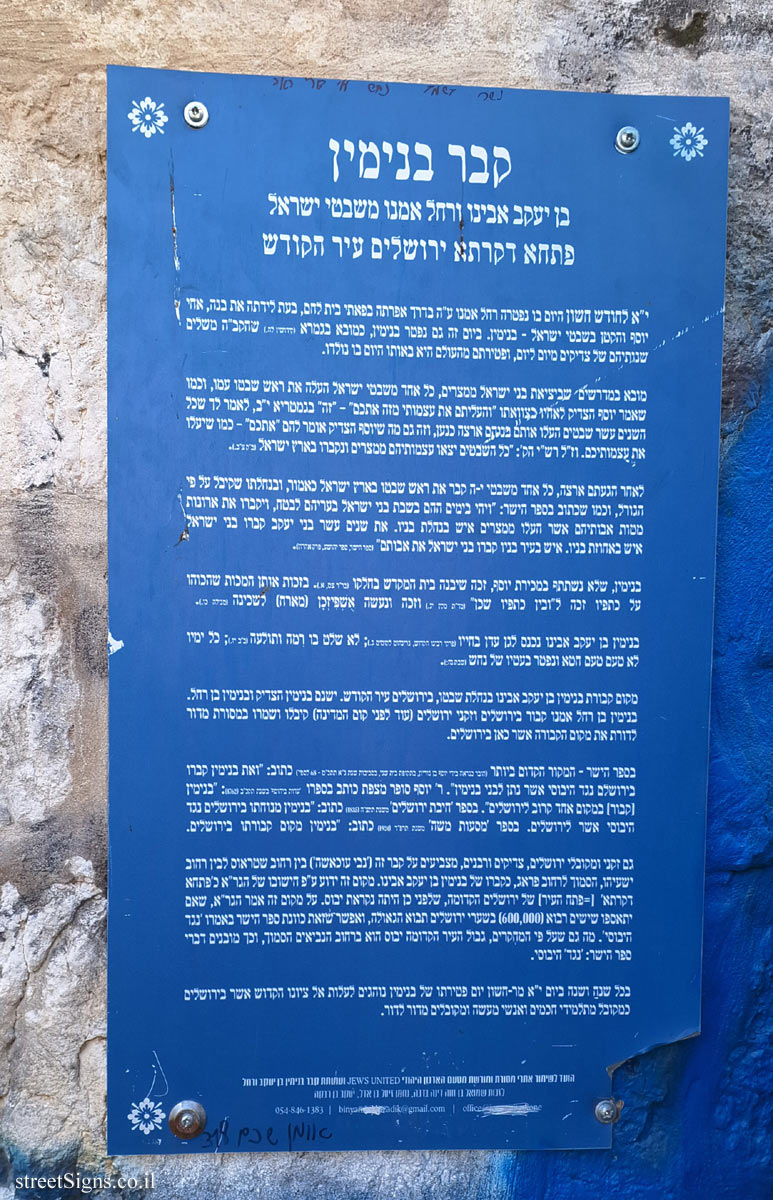According to archaeologists, the structure is an 800-year-old Muslim structure (i.e. from around 1200 AD) where members of the family of a Muslim general who fought in Saladin’s army are buried. In 2021, a group of Hasidim decided that this is the burial place of Benjamin ben Yaakov (our forefather Jacob).
According to tradition, Benjamin’s grave is located near Kfar Saba, but this did not prevent crowds of believers from visiting the place.
The structure was photographed on the same day
 Click for a larger image
Click for a larger image  Click for a larger image
Click for a larger image The second sign near the entrance is shown here in an enlarged version
 Click for a larger image Translation of the text on the sign
Click for a larger image Translation of the text on the sign:
Of Benjamin he said: The beloved of the LORD shall dwell in safety by Him; He covereth him all the day, and He dwelleth between his shoulders"
The Tomb of Benjamin, son of Jacob, our father, and Rachel, our mother
And his sons, Bela, Becher, Ashbel, Huphim
The "Tomb of Benjamin, Son of Jacob and Rachel" Association, for the sons of Shmuel, son of Eve, Dina, Bara, and Nachman, Zimel, son of Adel
[Another sign next to this sign, trying to confirm the identity of the tomb]
The Tomb of Benjamin, son of Jacob our father and Rachel our mother from the tribes of Israel
Patcha, Dekarta, Jerusalem, the Holy City
The 11th of the month of Cheshun, the day on which Rachel our mother, may God bless her and grant her peace, passed away on the road to Ephrathah on the outskirts of Bethlehem, while giving birth to her son, Joseph’s brother and the youngest of the tribes of Israel - Benjamin. On this day Benjamin also passed away, as stated in the Gemara (Kedushin 13) that God completes the years of the righteous from day to day, and their passing from this world is on the same day they were born.
It is stated in the Midrash concerning the Exodus of the Children of Israel from Egypt, that each of the tribes of Israel brought up the head of his tribe with him, and as the righteous Joseph said to his brothers as his will, "And you shall carry up my bones from here with you" - "this" in Gematria 12, to tell you that all twelve tribes brought them up with their sons to the land of Canaan, and this is also what the righteous Joseph says to them "with you" - as if they would carry up your bones. And the late Rashi said: "All the tribes left Egypt and were buried in the Land of Israel (BK 22b)
After they arrived in the land, each of the tribes of the Lord buried the head of his tribe in the Land of Israel as stated, and in his inheritance that he received according to the lot, and as it is written in the Book of the Law: "And it came to pass in those days that the children of Israel dwelt securely in their cities, and buried the coffins of the bodies of their fathers, which they had brought up out of Egypt, each in the inheritance of his sons. The children of Israel buried the twelve sons of Jacob, each in the inheritance of his sons. "Every man in the city of his sons, the children of Israel buried their fathers" (Sefer Yashar, Sefer Yehoshua, last chapter).
Benjamin, who did not participate in the sale of Joseph, was granted a share in building the Temple (Bar"R 77:1) by virtue of the same blows that struck him on his shoulders, he was granted "and between his shoulders he dwelt" (Mad"T Mekkats 13) and was granted and became a host (host) for the Shekhinah (Megillah 26)
Benjamin ben Yaakov Avinu entered the Garden of Eden during his lifetime (Pirkei Rabbeinu HaKadosh, Greenhus Lakotim 3) no worm or worm ruled over him (B"K 22:17) all his days he did not taste the taste of sin and died because of a snake (Shabbat 55)
The burial place of Benjamin ben Yaakov Avinu in his tribe’s inheritance, in Jerusalem, the Holy City. There are Benjamin the righteous and Benjamin ben Rachel. Benjamin ben Rachel, our mother, is buried in Jerusalem, and the elders of Jerusalem (even before the establishment of the state) accepted and preserved in a tradition from generation to generation the burial place here in Jerusalem.
In the Book of Truth - the earliest source (apparently composed by Joseph Ben Gurion, during the Second Temple period, around the year 68 B.C.) it is written: "And they buried Benjamin in Jerusalem opposite the Jebusites, who had given it to the children of Benjamin." Rabbi Yosef Sofer of Safed writes in his book (Edot Biyosef) in 1762: "Benjamin [is] buried in a place close to Jerusalem." In the book "Hivat Yerushalayim" (1835) it is written: "Benjamin rests in Jerusalem opposite the Jebusites who are in Jerusalem. In the book "Mas’ot Moshe" (1920) it is written: "Benjamin is the place of his burial in Jerusalem.
The elders and kabbalists of Jerusalem, righteous and rabbis, also point to this grave (’Nevi Okashah’) between Strauss Street and Yeshayahu Street, near Prague Street, as the grave of Benjamin ben Yaakov Avinu. This place is known according to the calculation of the Vilna Gaon as the ’Pecha Dekarta’ [=the entrance to the city] of ancient Jerusalem, which before that was called Jebus. Regarding this place, the Vilna Gaon said that if sixty thousand (600,000) gather at the gates of Jerusalem, redemption will come, And it is possible that this is what the Book of Righteousness means by saying ’against the Jebusite’. Moreover, according to research, the border of the ancient city of Jebus is on the nearby Prophets Street, and this is how the words of the Book of Righteousness are prepared: ’against’ the Jebusite.
Every year on the 11th of Mar-Chashon, the day of Benjamin’s death, it is customary to ascend to his holy Zion in Jerusalem, as is customary among scholars of Torah, men of action, and Kabbalists from generation to generation.
Committee for the Preservation of Tradition and Heritage on behalf of the Jewish organization JEWS UNITED and the Association for the Tomb of Benjamin Ben Jacob and Rachel
To the Honor of Shmuel Ben Chava Dina Bracha, Nachman Zissel Ben Adel, Jacob Ben Rivka
Learn about:

 Click for a larger image
Click for a larger image  Click for a larger image
Click for a larger image  Click for a larger image
Click for a larger image